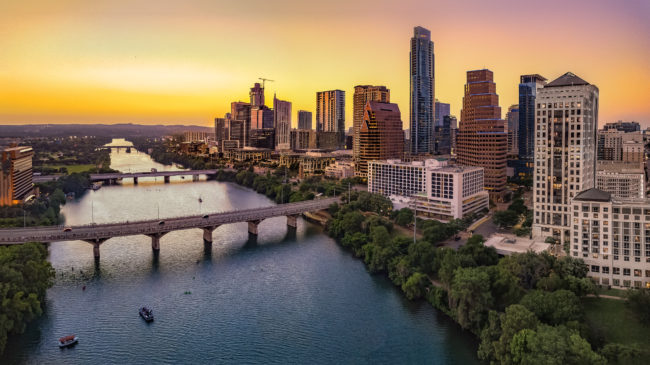With the coronavirus pandemic and recession reducing mass transit ridership, shifting consumer habits, and increasing costs for local governments, 2020 might be the worst time in recent history to approve new rail transit lines. Yet, that did not stop Austin, Texas, voters from approving Proposition A, the most ambitious mass transit ballot question in the city’s history.
The proposition permanently increases the city’s property tax rate to fund a $7.1 billion mass transit system. The plan would build two new light rail lines, a rail tunnel downtown, a commuter rail line, add multiple new rapid bus routes, and provide funding for low-income residents displaced from their housing.
The city’s voters had rejected rail propositions twice before, once in 2000 and again in 2014.
With many employees working from home due to COVID-19, demand for transit infrastructure has fallen significantly across the country and in Austin. Surveys from the Central Texas Regional Mobility Authority (CTRMA) indicate that traffic has decreased during the pandemic and some of this reduction may be permanent, as companies and workers learn to utilize technologies and shift to work-from-home options.
There is currently bipartisan sentiment against starting new capacity projects until we see what the transportation and the economic landscape looks like when the coronavirus pandemic is under control. A recent Reason Foundation brief recommended pausing all new capital construction projects while the world waits for a COVID-19 vaccine and for people to fully be able to resume work, school and other activities. Many state departments of transportation and transit agencies are shifting their capital funding into maintenance funding, to improve things like pavement quality while road use is down.
Austin Mayor Steve Adler, who supported the rail expansion, views Prop. A as a huge jobs program, “which is something the city is going to want,” he said. Adler called the transit program “transformational” and suggested, “the ultimate cost of not doing this is greater than the cost of doing it now.”
Unfortunately for Austin, data show transportation spending does not create many jobs because infrastructure projects like these are typically less labor-intensive than other public works investments, and the labor that is required for them tends to be highly specialized.
Austin’s rail ambitions are not cheap.
The city’s property tax rate is expected to increase more than 20 percent under Proposition A. However, the numbers vary based on geography and housing cost. In Travis County, the average property tax bill will increase by around $340 per year, but in other counties the tax increase will be higher.
There’s also the question of whether the light rail line can be completed on budget. When applying for Federal Transit Administration funding, project sponsors have learned that it is not unusual to see the rail projects seeking funding end up underestimating costs by one-third while also overestimating ridership by one-third. Only 10 percent of large rail projects are completed on-time and on-budget. The average budget cost overrun for rail projects is more than 80 percent.
The city’s plan is to build the $2.5 billion Orange Line and the $1.2 billion Blue Line in nine years. Proposition A also includes a $2 billion downtown tunnel, which would function as a subway line connecting the Orange and Blue lines with Austin’s existing Red Line commuter rail. Additionally, a new Green Line commuter rail line is in the plan, but its construction wouldn’t begin for at least eight years.
Austin’s leaders are expecting the federal government to pick up 45 percent of the overall price tag for these projects, a large number for the rapidly growing metro area, now the country’s 11th largest city, with such low transit usage. The federal government is usually more likely to fund rail lines with a greater local match. If Los Angeles asks for a 20 percent federal match, for example, its rail system would likely be prioritized and get federal funding before Austin’s.
The city’s plan does have some useful bus rapid transit lines in it. Austin plans to expand its Metro Rapid routes along Pleasant Valley and Manchaca roads. In fact, the plan includes numerous rapid routes that can be implemented in less than five years for $170 million, a tiny fraction of the proposition’s cost. The Orange Line, by itself, costs 15 times more than all the bus rapid transit lines put together, for example.
Given the high-quality and low-cost realities of bus lines, Austin could have created a world-class bus transit system cost-effectively by focusing on bus rapid transit. Instead of building three rail lines and a smattering of bus lines over 20 years, the city could have built an entire bus rapid transit (BRT) network.
Bus rapid transit is three-to-nine times cheaper to build than light rail, yet it is no less popular. Mass transit riders value frequent, on-time service. The reason many riders shun conventional buses is that they typically offer slow or unpredictable service on subpar vehicles. But BRT, with modern and higher quality buses, on-time service, WiFi for riders, and other amenities, has the same level of rider satisfaction as rail.
Many cities have been distracted by the allure that rail seems to have for politicians and planners through the years. But if past light-rail performance in those cities is any guide, we can expect that Austin’s taxpayers will likely end up paying more than expected, waiting longer for project completion than they’ve been promised, and, ultimately, be no more satisfied with the end result of this limited, rigid rail system than they would have been with more flexible, cost-effective alternatives like bus rapid transit.

